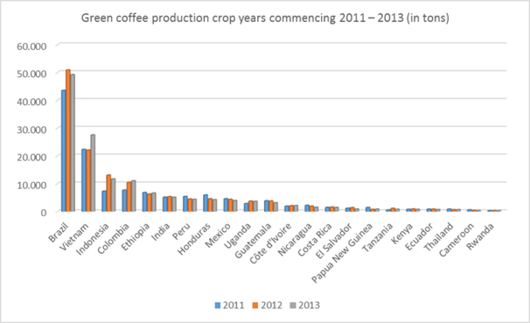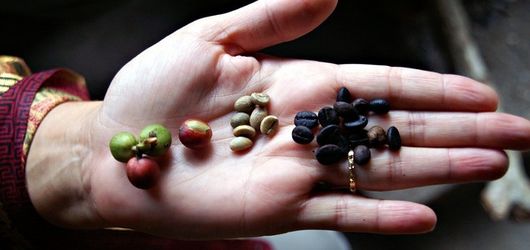Course:SPPH381B/TermProject/Coffee Beans
Coffee Beans
Coffee beans are primarily used to create coffee, one of the most popular drinks in the world.[1]. Dried coffee beans, which are actually seeds of coffee fruits, are roasted, ground, and brewed to create the hot beverage. Drinking coffee has been shown to be either benign or slightly beneficial for human health.[2]
The two main varieties of the coffee plant are the Arabica and the Robusta. Arabica accounts for around 80% of coffee consumed worldwide while Robusta accounts for 20%.[3] Arabica beans are typically a more desireable product, as they produce coffee with milder and more aromatic flavours. Some coffee producers still prefer to grow Robusta, as the plants are easier to grow, more resistant to unfavorable conditions, and produce up to 3 times as much coffee as an Arabica plant. Additionally, Robusta coffee beans contain significantly more caffeine compared to Arabica.[4]
Caffeine is a naturally occurring stimulant. A typical 8oz cup of brewed coffee contains 95mg to 200mg of caffeine.[5] Caffeine is by far the most widely-used stimulant. 90% of adults in North America consume caffeine on a daily basis.[6] People who consume upwards of 100mg of caffeine per day are at risk of developing mild physical dependence. Breaking this dependence would trigger withdrawal symptoms including headaches, muscle pain, depressed mood, and irritability.[7]
Background
Evidence for coffee drinking goes back as far as the 15th century.[8] Eventually, through trade, coffee was shared with the rest of the world. It is thought that seven million metric tons of coffee were produced in 2010.[9]
In the modern world, coffee is a highly profitable industry. It is the top agricultural export for many countries.[10] For example, Brazil's coffee sector employs over 5 million people and produces 40% of the world's total coffee supply. The second largest producer is Vietnam at 16%.[11]
Worker Vulnerabilities
Global corporations such as Nestle are always under pressure to increase their profit margins. Combine this with the statistic that over 90% of coffee production happens in developing countries and you have a high potential for unsafe working conditions.[12]
Migrant workers hired to pick coffee are typically at the greatest risk. Housing conditions can be poor with up to 60 people in one building. Training is usually not adequate, but even when it is, workers usually do not have the correct protective equipment (for example, when using pesticides). Additionally, wages are low and workers rarely sign a contract. Perhaps the most disturbing fact is that a significant number of coffee farms employ children to pick their coffee.[13]
Life-cycle
Coffee bean production and use consists of the following broad steps:
- Coffee tree farming produces coffee cherries (resource extraction)
- Processing (dry method) produces dried green coffee beans (primary manufacturing)
- Roasting produces roasted coffee beans (secondary manufacturing)
- Power generation and transport infrastructure support these processes (support infrastructure)
- Shipped by road, rail, or cargo ship (transportation)
- Used coffee grounds are either thrown out or composed (disposal)
In most cases, the dried green coffee beans (produced by primary manufacturing) are transported to a different location for roasting (secondary manufacturing).
Process details
Coffee tree farming
- Growing and sustaining the coffee tree plants
- Coffee cherry picking
- Transporting coffee cherries
Processing (dry method)
Coffee can be processed using either a wet method or a dry method. We will focus on the dry method here.
- Cleaning and sorting the coffee cherries
- Drying process
- Coffee cherry milling
At the end of this process, the coffee cherries have been turned into dried green coffee beans.
Roasting
After roasting, roasted coffee beans have been created from the dried green coffee beans.
Infrastructure
- Road, rail, port, truck, train, ship construction
- Road, rail, port, truck, train, ship maintenance
- Traffic control and administration
- Hydroelectric power generation
In Brazil, the top coffee producing nation in the world, 72.1% of energy is produced by hydroelectric power plants.[14]
Shipping
- Loading
- Driving
- Unloading green coffee beans
- Warehousing
Disposal
- Throwing out or composting coffee grounds
Conclusion
Coffee beans start as coffee cherries on coffee trees. Workers, typically working long hours in developing countries, pick the cherries. The cherries are then processed into green coffee beans. During the process, workers can be exposed to green coffee dust, which is a respiratory sensitizer. The green coffee beans can then be roasted. A surprising hazard during the roasting process is that the chemical diacetyl is produced. Diacetyl can cause harmful lung diseases. Used coffee grounds can be composed and aren't typically associated with any serious hazards.
Around 125 million people across the world depend on coffee production for their livelihood.[15] With such a significant number of people involved, the risks across all steps of the process need to be investigated and reduced.
References
- ↑ Oder, Tom (June 9, 2015). "How coffee changed the world". Mother Nature Network. Retrieved March 29, 2017.
- ↑ Nehlig, A. (2015). "Effects of coffee/caffeine on brain health and disease: What should I tell my patients?". Practical Neurology. 16 (Dec 16): 89–95.
- ↑ "Arabica and Robusta Coffee Plant". Coffee Research Institute. Retrieved 25 August 2011.
- ↑ http://www.barkingdogroasters.com/our-coffee/arabica-vs-robusta/
- ↑ http://www.mayoclinic.org/healthy-lifestyle/nutrition-and-healthy-eating/in-depth/caffeine/art-20049372
- ↑ Lovett R (24 September 2005). "Coffee: The demon drink?". New Scientist (2518). Retrieved 1 April 2017.
- ↑ Studeville, George. “Caffeine Addiction Is a Mental Disorder, Doctors Say.” National Geographic. Jan. 15, 2010. http://news.nationalgeographic.com/news/2005/01/0119_050119_ngm_caffeine.html. Retrieved April 2, 2017.
- ↑ Weinberg & Bealer 2001, pp. 3–4
- ↑ FAO (2003). "Coffee". Medium-term prospects for agricultural commodities. Projections to the year 2010. Food and Agriculture Organization of the United Nations. Retrieved March 29, 2017.
- ↑ "FAOSTAT Core Trade Data (commodities/years)". FAO Statistics Division. 2007. Archived from the original on October 14, 2007. Retrieved March 29, 2017.
- ↑ http://www.ecf-coffee.org/about-coffee/coffee-facts. Retrieved Apr 1, 2017.
- ↑ Ponte, Stefano. "The 'Latte Revolution'? Regulation, Markets and Consumption in the Global Coffee Chain". World Development. Elsevier Science Ltdlume=30: 1099–1122.
- ↑ http://dailycoffeenews.com/2013/07/17/farmworkers-left-behind-the-human-cost-of-coffee-production/. Retrieved Apr 2, 2017.
- ↑ Ministry of Energy and Mines, 2007
- ↑ http://fairtrade.ca/en-ca/farmers-and-workers/coffee. Retrieved April 2, 2017.


